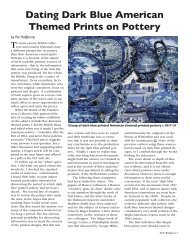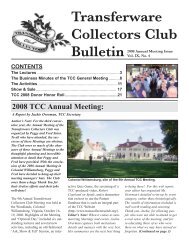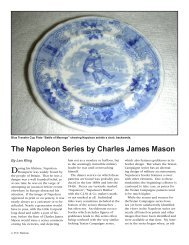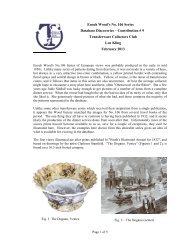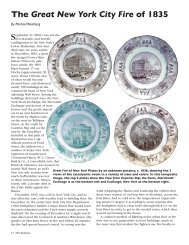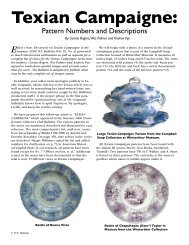A Brief History of Transfer Printed Tiles - Transferware Collectors Club
A Brief History of Transfer Printed Tiles - Transferware Collectors Club
A Brief History of Transfer Printed Tiles - Transferware Collectors Club
Create successful ePaper yourself
Turn your PDF publications into a flip-book with our unique Google optimized e-Paper software.
A <strong>Brief</strong> <strong>History</strong> <strong>of</strong> <strong>Transfer</strong> <strong>Printed</strong> <strong>Tiles</strong><br />
By Wendy Harvey<br />
Mass<br />
produced<br />
transfer printed<br />
tiles trace their history<br />
to the tiles first produced<br />
by printer John<br />
Sadler and his partner<br />
Guy Green in the year<br />
1756. On a sworn affidavit<br />
Sadler states<br />
“without the aid or assistance<br />
<strong>of</strong> any person<br />
or persons, did, within<br />
the space <strong>of</strong> six hours,<br />
to wit, betwixt the hours<br />
<strong>of</strong> nine in the morning<br />
and three in the afternoon<br />
<strong>of</strong> the same day,<br />
print upwards <strong>of</strong> twelve<br />
Fireplace Surround w/ Sadler & Green <strong>Tiles</strong>.<br />
hundred earthenware<br />
tiles <strong>of</strong> different patterns, at Liverpoole [sic] aforesaid, and<br />
which as these depondents have heard and believe, were<br />
more in number and better and neater, than one hundred<br />
skillful pot painters could have painted in the like space <strong>of</strong><br />
time in the common and usual way.” (Van Lemmon p.127)<br />
Using available handmade white tin glazed delftware<br />
tiles, John Sadler applied the newly developed method<br />
<strong>of</strong> printing on ceramics to tiles. This printing method allowed<br />
for an image engraved onto a copper plate or cut<br />
from a wood block to be transferred to a tile using paper<br />
or a glue bat. The image<br />
could then be fired<br />
at a relatively low temperature<br />
for a very brief<br />
time (15 minutes). This<br />
method had the obvious<br />
advantage <strong>of</strong> hastening<br />
production both<br />
in decoration and firing.<br />
However, since the<br />
decoration was placed<br />
atop the tin glaze it was<br />
subsequently much less<br />
durable and subject to<br />
wear.<br />
The first decorations<br />
that Sadler and Green<br />
produced were reminiscent<br />
<strong>of</strong> Dutch tiles. Since there was huge demand for blue<br />
painted Dutch tiles originating from Liverpool as well as<br />
from Holland, it is easy to see that this was an obvious<br />
attempt to compete in a well established marketplace. In<br />
fact, a certificate by Thomas Shaw and Samuel Gilbody, attached<br />
to the Sadler affidavit, states, “We are also assured<br />
that the Dutch may by this improvement be considerably<br />
undersold.” (Van Lemmon p.128) The original Dutch design<br />
“copies” were soon abandoned and tile designs included<br />
romantic themes, genre scenes, ships, fables and<br />
fashionable society encapsulated by elaborate or scrolled<br />
2 Examples <strong>of</strong> early 19 th Century Sadler and Green <strong>Tiles</strong>.<br />
TCC Bulletin 17
health following the cholera epidemics<br />
<strong>of</strong> 1831-32 and 1848-49. These<br />
epidemics provided the impetus for<br />
changes in the sewage system and the<br />
first public sewers were built in 1858-<br />
1874 replacing open cesspools. Upper<br />
class homes had indoor toilets and<br />
bathrooms by mid century and most<br />
homes had indoor plumbing by the<br />
end <strong>of</strong> the century.<br />
The Crystal Palace, London, site <strong>of</strong> the Great Exposition <strong>of</strong> 1851:<br />
Minton tiles featured there were seen by 10s <strong>of</strong> thousands <strong>of</strong> English<br />
consumers.<br />
and twisted borders were produced.<br />
The tiles were printed in black, red or<br />
brown as the traditional Dutch cobalt<br />
blue oxide proved difficult to use on<br />
copper plates.<br />
The business expanded and Sadler<br />
and Green began a partnership with<br />
Josiah Wedgwood and started fairly<br />
extensive decoration <strong>of</strong> Wedgwood’s<br />
creamware even at the expense <strong>of</strong><br />
their own tile making. Over the next<br />
years, others makers started production<br />
<strong>of</strong> printed tiles and, after 12 years,<br />
Wedgwood started his own facility for<br />
printing creamware and tiles.<br />
<strong>Transfer</strong> printed Sadler and Green<br />
tiles were not only used in England,<br />
they were also exported. Fine colonial<br />
homes in America used Sadler and<br />
Green tiles around the fireplaces and<br />
more examples <strong>of</strong> Sadler and Green<br />
tiles remain in situ here than in England.<br />
As anticipated by Shaw and Gilbody,<br />
Sadler and Green’s use <strong>of</strong> transfer<br />
printing contributed to the demise<br />
<strong>of</strong> the British delftware industry.<br />
<strong>Transfer</strong> printed tin-glazed tile use<br />
declined in the 1780’s. This may have<br />
been due to changing fashion or the<br />
tendency for the tiles to craze when<br />
exposed to heat or the previously mention<br />
lack <strong>of</strong> durability. This decline in<br />
tin-glazed tile use signaled the end <strong>of</strong><br />
transfer printed tiles until the middle<br />
<strong>of</strong> the nineteenth century.<br />
The New Age <strong>of</strong><br />
transfer printed tiles<br />
Beginning in 1828, Herbert Minton,<br />
son <strong>of</strong> Thomas Minton founder <strong>of</strong> the<br />
firm, became interested in encaustic<br />
tile production. His interest coincided<br />
with a renewed interest in Gothic<br />
architecture and technological innovations.<br />
Herbert had the foresight to<br />
anticipate the market for tiles and the<br />
wealth and business savvy to do so.<br />
Extolling the virtues <strong>of</strong> tile, he used<br />
his club connections with prominent<br />
architects and Prince Albert to create<br />
demand and cachet. Following the<br />
club demonstration, Queen Victoria<br />
and Prince Albert used Minton encaustic<br />
floor tiles in their home on the Isle<br />
<strong>of</strong> Wight. Building on his successes,<br />
Minton soon expanded his production<br />
into transfer printed and relief wall<br />
tiles. He was quickly joined by other<br />
tile producers.<br />
Concurrent with the significant<br />
mechanical advances that made mass<br />
production <strong>of</strong> tiles possible, there was<br />
an increased awareness <strong>of</strong> disease and<br />
Believing that the odors in the air<br />
carried diseases, reformers began advocating<br />
for building with non-porous<br />
surfaces just as city planners were advocating<br />
for non-flammable building<br />
materials following several devastating<br />
city fires, including one at the Palace<br />
<strong>of</strong> Westminster in 1834. Doctors and<br />
architects campaigned for the use <strong>of</strong><br />
tiles as practical, beautiful, and washable<br />
for use in the new bathrooms,<br />
kitchens, sculleries and food shops.<br />
Style advocates and trendsetters urged<br />
the use <strong>of</strong> tiles around the fireplace.<br />
Desire for tiles was fostered in the<br />
rapidly increasing middle classes by<br />
their exposure to the Great Exposition<br />
<strong>of</strong> the Works <strong>of</strong> Industry <strong>of</strong> All Nations<br />
<strong>of</strong> 1851. Championed by Prince Albert,<br />
the exhibition building covered<br />
700,000 square feet and hosted 17,000<br />
exhibitors from countries as far away<br />
as China. Minton displayed a huge se-<br />
Portrait <strong>of</strong> Herbert Minton,<br />
who’s foresight brought the Minton<br />
Pottery to the forefront <strong>of</strong><br />
English tile production.<br />
18 TCC Bulletin
lection <strong>of</strong> wall and floor tiles at the exhibition.<br />
One third <strong>of</strong> the population<br />
<strong>of</strong> Great Britain at the time, 6.2 million<br />
people, attended. They were brought<br />
to the exposition from the countryside<br />
by the newly constructed railroads<br />
which made transportation faster and<br />
safer. Telegraphs and newspapers<br />
spread the excitement and wonders <strong>of</strong><br />
the exhibition throughout the world.<br />
England was the most powerful<br />
nation in Europe in 1850 and exerted<br />
enormous worldwide influence. English<br />
building throughout the Empire<br />
and world expansion created a ready<br />
marketplace for tiles. Steamships ensured<br />
quick and dependable transport<br />
<strong>of</strong> goods. As early as 1838, the use <strong>of</strong><br />
steamships had reduced the travel time<br />
to cross the Atlantic to a mere 19 days.<br />
<strong>Transfer</strong> printing which used one<br />
color and the similar block printing<br />
process which used many colors enabled<br />
a wide variety <strong>of</strong> patterns and<br />
design subjects to be produced efficiently<br />
and economically. Minton and<br />
the other tile manufactures employed<br />
both in-house and free lance artists<br />
to design and/or engrave scenes both<br />
historic and imagined. Artists drew<br />
upon interests <strong>of</strong> the era such as the<br />
natural world, history, ancient civilizations,<br />
literature, and science. Tile output<br />
during the last half <strong>of</strong> the century<br />
was extensive and both the quality and<br />
quantity produced remains unrivaled<br />
to this day.<br />
<strong>Transfer</strong> decorated tiles from the last quarter <strong>of</strong> the 19 th Century.<br />
In 1876, the Philadelphia Exhibition<br />
included elaborate displays <strong>of</strong><br />
English tiles from 15 tile and 13 terra<br />
cotta companies. These impressive<br />
displays <strong>of</strong> tiles gave rise to the American<br />
tile industry and by 1885 there<br />
were at least 25 American tile producers.<br />
Drawing on the expertise <strong>of</strong> the<br />
British tile industry, most <strong>of</strong> the American<br />
companies were started with English<br />
potters, artists, and ceramicists,<br />
and initial American tiles were similar<br />
or identical copies <strong>of</strong> English production.<br />
Very quickly, however, the U.S.<br />
tile makers developed unique products<br />
and glazes. The American tile industry<br />
was a significant one until about<br />
1929, but very few transfer printed<br />
tiles were ever produced here.<br />
Partial Bibliography:<br />
Atterbury, P. and Batkin, M., The<br />
Dictionary <strong>of</strong> Minton Suffolk 1990<br />
Austwick, J.&B. The Decorated Tile<br />
London 1980<br />
Barnard, J. Victorian Ceramic <strong>Tiles</strong><br />
London 1972<br />
Batkin, M. Wedgwood Ceramics<br />
1846-1959 London 1981<br />
Herbert,T.& Huggins,K. The Decorative<br />
Tile London 1995<br />
Lewis, G. A Collector’s <strong>History</strong> <strong>of</strong><br />
English Pottery Suffolk 1992<br />
Lockett, T. Collecting Victorian <strong>Tiles</strong><br />
Suffolk 1979<br />
Van Lemmon, H. Delftware <strong>Tiles</strong><br />
London 1997<br />
Van Lemmon, H. <strong>Tiles</strong>, 1,000 Years<br />
<strong>of</strong> Architectural Decoration London<br />
1993<br />
English <strong>Tiles</strong> in America<br />
America proved to be a fertile marketplace<br />
for English tiles for the same<br />
reasons they were used in England,<br />
and many English tile companies had<br />
<strong>of</strong>fices and/or representatives in major<br />
U.S. cities. American fashion for tiles<br />
was, in part, created by the writings<br />
<strong>of</strong> Andrew Jackson Downing, a prominent<br />
American landscape designer,<br />
writer and advocate <strong>of</strong> the Gothic Revival<br />
style in the U.S. In 1850, he published<br />
an extremely influential book<br />
entitled; “The Architecture <strong>of</strong> Country<br />
Houses.” In his book, Downing advocated<br />
the extensive use <strong>of</strong> tiles.<br />
Mintons Tile display at the 1876 Philadelphia (Centennial) Exposition,<br />
one <strong>of</strong> a number <strong>of</strong> English tile displays credited with igniting the<br />
American tile industry, which thrived until 1929.<br />
TCC Bulletin 19



